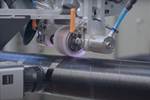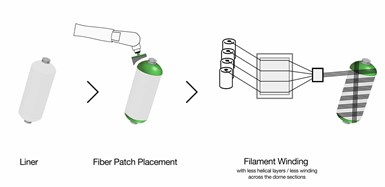Cevotec fiber patch placement improves storage efficiency of composite tanks
Cevotec’s solution is to apply carbon fiber patches to the dome areas of Type IV pressure vessels, which reportedly yields 15% in material, weight and cost savings.

Cevotec fiber patch placement process for composite tanks. All photo credit: Cevotec
Cevotec (Unterhaching, Germany) reports that it has developed an industrial solution to improve the storage efficiency of Type IV composite tanks in hydrogen-powered electric vehicles (EVs), reducing the amount of carbon fibers consumed by up to 15% while maintaining equivalent mechanical properties.
Cevotec’s solution is to apply carbon fiber patches in the tank’s dome areas, thereby replacing the high-angle helical layers (HAHL) in a typical filament winding pattern. Reinforcing a tank’s dome area with its fiber patch placement (FPP) technology reportedly yields 15% in material, weight and cost savings, and shortens total manufacturing time by 20%. By using FPP dome reinforcements, Cevotec says that manufacturers need less material in the subsequent filament winding process.
Cevotec’s fully automated, quality-controlled SAMBA FPP system first places the reinforcing fiber patches at the dome area directly on a standard liner. Then the patched liners are transferred over to the filament winding process; SAMBA requires no additional post-processing. The winding process is then adjusted to leave out the HAHL layers, for a faster, less material-intensive process, increasing overall line capacity for tanks, which further improves ROI and production economics
Related Content
-
McLaren celebrates 10 years of the McLaren P1 hybrid hypercar
Lightweight carbon fiber construction, Formula 1-inspired aerodynamics and high-performance hybrid powertrain technologies hallmark this hybrid vehicle, serve as a springboard for new race cars.
-
PEEK vs. PEKK vs. PAEK and continuous compression molding
Suppliers of thermoplastics and carbon fiber chime in regarding PEEK vs. PEKK, and now PAEK, as well as in-situ consolidation — the supply chain for thermoplastic tape composites continues to evolve.
-
Sulapac introduces Sulapac Flow 1.7 to replace PLA, ABS and PP in FDM, FGF
Available as filament and granules for extrusion, new wood composite matches properties yet is compostable, eliminates microplastics and reduces carbon footprint.













